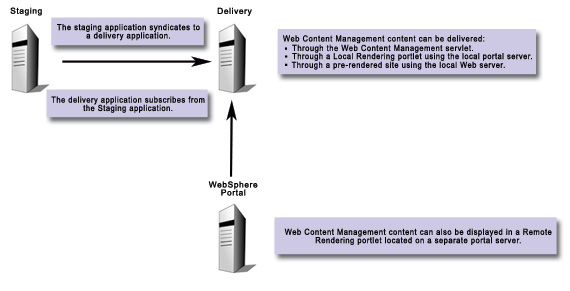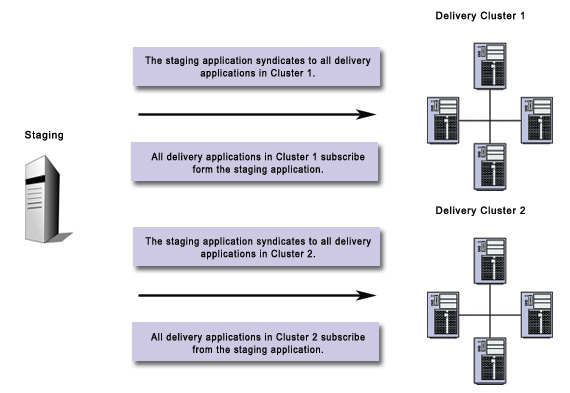Portal Express, Version 6.0
Operating systems: i5/OS, Linux, Windows
Delivery options
There are several different ways you can choose to deliver IBM® Workplace Web Content Management™ content to users, including rendering portlets, a specialized servlet, and pre-rendered sites.
There are four different methods available to deliver Web Content Management sites.
| Local Rendering Portlet (Web Content Viewer) | Web Content Management content can be delivered via a Local Rendering Portlet located on the same server as a Web Content Management application. See Displaying content in a rendering portlet for further information. |
| Remote Rendering Portlet (Remote Web Content Viewer) | Web Content Management content can be delivered via a Remote Rendering Portlet located on a IBM WebSphere® Portal Express server. A Web Content Management application is not required. See Displaying content in a rendering portlet for further information. |
| Web Content Management servlet | Web Content Management content can be delivered as a standard Web Site via the Web Content Management servlet that is installed with the Web Content Management application. See Accessing Web content via a servlet for further information. |
| Pre-rendered sites | Web Content Management content can also be delivered as a standard web site via a pre-rendered site. See Pre-rendered sites for further information. |
Basic delivery
Web Content Management content can be delivered:- Through the Web Content Management servlet.
- Through a local rendering portlet using the local portal server.
- Through a remote rendering portlet located on a separate portal server.
- Through a pre-rendered site using the local Web server.

Syndication
Syndication is used as the transport layer that replicates data from one Web Content Management application to another. Further information can be found in the Syndication chapter later in this guide.
Clustered delivery
A set of delivery applications can be installed as a cluster. This provides in-built redundancy. A load-balancer can be used in-front of a clustered set of delivery applications. Syndication is enabled between the staging application and all delivery applications.

Staging applications can Syndicate to more than one cluster of delivery applications allowing separate delivery clusters to be installed at different locations.

- Syndication: Syndication is used as the transport layer that replicates data from one Web Content Management application to another. Further information can be found in the Syndication topic.
- Clustering: Refer to the Clustering and WebSphere Portal Express topic for information on installing a clustered environment.
- Load balancing: Refer to the documentation of your load balancer for information on how to enable load balancing.
Parent topic:
Configuring a delivery server